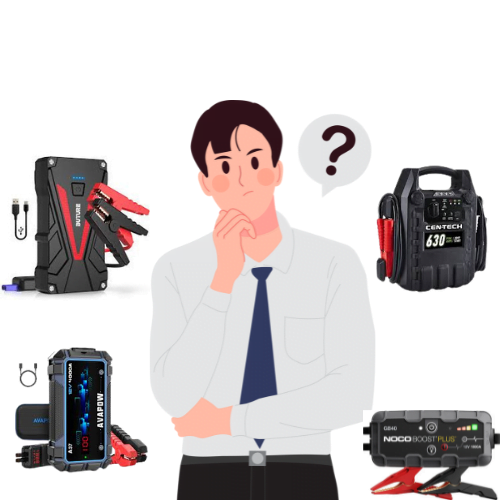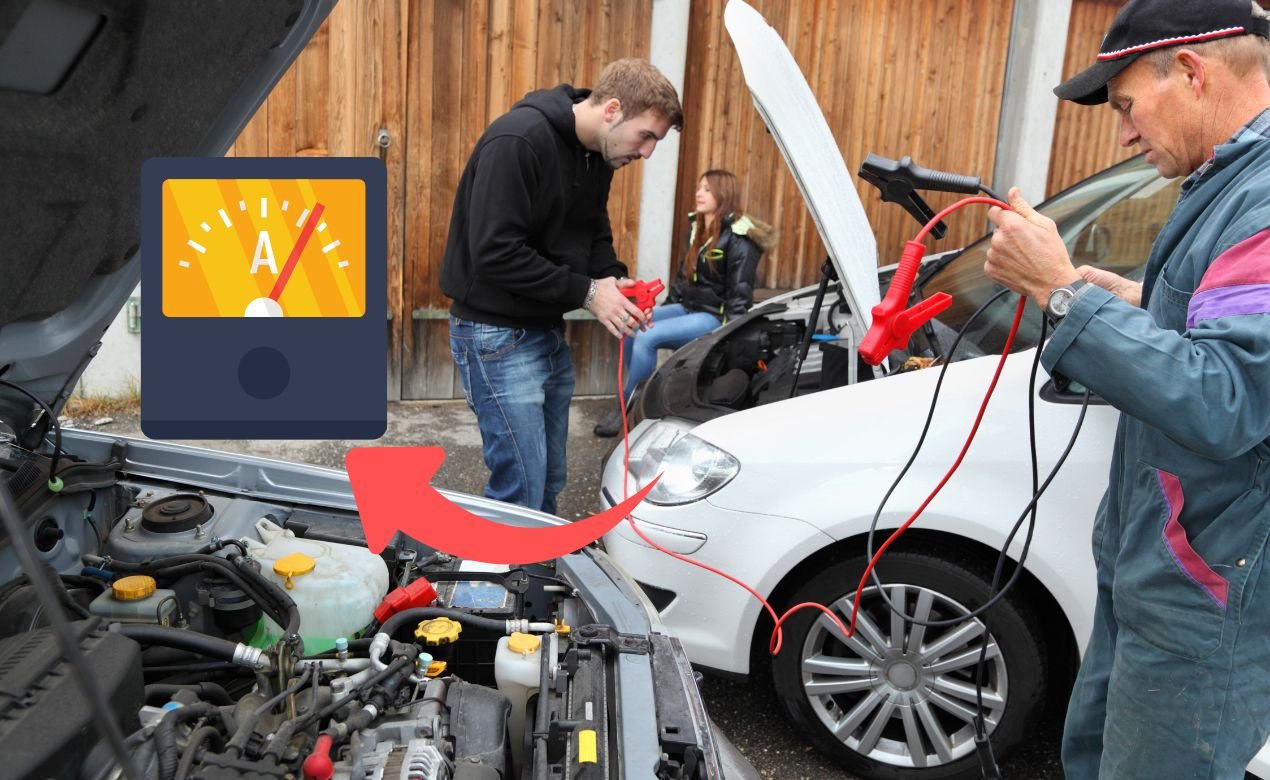We’ve all been there—sitting in the driver’s seat, turning the key, and getting nothing but a click. A dead battery, out of the blue, and now you’re stuck. It’s frustrating, especially if you’re in a hurry. When I faced this situation, I thought that how many amps are needed to jump start a car?I’ve learned from experience that having the right jump starter is more than just convenient; it’s essential. Learn the right way to charge a portable jump starter to keep it ready.
One of the first things you need to know when picking a jump starter is how many amps your car needs to get going. It’s not a one-size-fits-all situation. Smaller cars, like sedans with 4-cylinder engines, typically need around 300 to 400 amps to jump-start.
But if you’re driving a larger vehicle, like an SUV or a truck, the requirements can shoot up to 600 to 800 amps or more. There was one time when I was stuck in freezing weather with a drained battery in my truck. It took a jump starter with 1,000 amps to get the engine turning. Without knowing the proper amp requirements, I would’ve wasted time and energy with a smaller, less powerful unit.
Key Factors in Choosing the Right Jump Starter

When it comes to choosing the right jump starter, I’ve learned that there are a few key factors you just can’t ignore. Over the years, I’ve dealt with more dead batteries than I’d like to admit, and understanding these factors has saved me more than once. Find out how long to leave cars connected when jump-starting for optimal results.
Understanding How Many Amps Are Needed to Jump Start a Car?
One of the first things I check before picking a jump starter is the engine size. The bigger the engine, the more power it needs to start.
Here’s a simple way to break it down:
- Small Cars (like a Toyota Corolla): Need about 150 cold-cranking amps to jump-start.
- Mid-Sized SUVs: You’ll be looking at around 400-500 amps.
- Large Trucks (like a Chevy Suburban): These beasts will require anywhere from 600 to 800 amps.
Larger engines need more power to get going, especially when the battery is completely drained.
Don’t Forget the Vehicle’s Age
I’ve found that older vehicles tend to need more power. If your car is more than 5 years old, the battery has likely lost some of its original efficiency. That means more juice is needed to get the engine running.
- Older Cars (5+ years): Consider a jump starter that delivers at least 600 amps, even for smaller engines.
- Newer Cars: You can usually get away with something in the 200-400 amp range.
The general rule I follow is to choose a jump starter that can handle my oldest and biggest vehicle. Even if you have a compact car, it’s better to be safe than stranded.
Environmental Impact
Where you drive matters more than most people realize. Living in a cold climate myself, I’ve learned that freezing temperatures can turn an easy jump start into a real challenge. Cold weather reduces a battery’s effectiveness, so you need more power to start your vehicle.
- Winter Driving: I recommend using a jump starter with at least 500 amps in cold conditions.
- Extremely Cold Weather (below -30°F): You’ll want a jump starter that can operate in extreme temperatures. I’ve seen models that can work at -40°F, which is a lifesaver in freezing environments.
If you’re in a milder climate, you won’t need as much power, but always factor in the coldest conditions you might face.
Practical Guide: Selecting the Right Jump Starter for Your Vehicle

When it comes to selecting a jump starter, I’ve learned that one size doesn’t fit all. Over the years, I’ve seen plenty of people get stuck with a dead battery because they didn’t pick the right tool. So, let me break it down for you in a way that’s practical and easy to follow.
The first thing you need to know is that your vehicle’s engine size and type matter a lot when choosing a jump starter. Here’s a quick breakdown of what you should look for:
- Small Cars (1.0L to 3.0L engines): A jump starter with 400 to 600 amps will usually do the trick. Think of compact sedans like a Toyota Corolla or Honda Civic.
- Midsize Vehicles (3.0L to 5.0L engines): If you’re driving something like a Ford Explorer or a Jeep Wrangler, you’ll want a jump starter that delivers between 600 to 800 amps.
- Large Trucks and SUVs (5.0L and above): For bigger vehicles like a Chevy Suburban or a diesel-powered truck, you’ll need something with 800 to 1,200 amps. Diesel engines, in particular, need more power to start.
Now, if you’re not sure about your engine size, just check your car’s manual or do a quick Google search. It’s better to know exactly what you need than to be guessing when your battery dies. Discover the best jump starters for EVs to meet your electric vehicle’s needs.
Choosing Based on Engine Type
One thing I’ve found is that diesel engines require more cranking power than gasoline engines. So, if you’re driving a diesel truck, don’t cut corners—go for a jump starter with at least 1,000 amps.
For example, a model like the J302 with 2500A can handle diesel engines up to 6.5L. It’s perfect for heavier-duty vehicles. Check out the best jump starters for diesel trucks for reliable power.
A Simple Guide to Help You Choose
Here’s a quick reference you can use when selecting your jump starter:
- Up to 4.5L Diesel / 7.0L Gasoline: 1,500 amps is enough.
- Up to 6.0L Diesel / 8.0L Gasoline: You’ll need about 2,000 amps.
- Up to 6.5L Diesel / 8.5L Gasoline: Go for 2,500 amps or higher.
Avoid Over-Amperage
While more amps can sound like a good thing, be careful not to overdo it. Using a jump starter with too many amps can actually damage your car’s electrical system. Stick with the range your engine requires.
How to Safely Use and Maintain Your Jump Starter
From personal experience, using a jump starter the right way can save you from a lot of headaches. It’s one thing to have the device, but if you don’t know how to use it properly, it could lead to bigger problems. Let’s go through some quick and easy steps to make sure you’re ready when the time comes.
Safe Jump-Starting Steps
First things first, you need to connect your jump starter correctly. If you don’t, you could short-circuit your car or even damage the jump starter itself. Here’s how I do it every time:
- Step 1: Make sure both vehicles are turned off.
- Step 2: Connect the red (positive +) clamp to the positive terminal on the dead battery.
- Step 3: Attach the black (negative -) clamp to an unpainted metal surface on the engine block or car frame. This acts as a ground.
- Step 4: Start the vehicle with the working battery and let it run for about 3-5 minutes.
- Step 5: Try starting the dead vehicle. If it doesn’t start immediately, give it another minute or two.
Once the vehicle starts, leave it running for at least 15 minutes before you drive off. This allows the alternator to recharge the battery. Always remember to disconnect the clamps in reverse order. Wondering if a battery charger can charge your jump starter? Get the answer in our guide on charging a jump starter with a battery charger.
Maintaining Your Jump Starter
Owning a jump starter isn’t just about keeping it in the trunk and forgetting about it. From my experience, if you don’t maintain it, it might fail when you need it most. Here are a few ways to keep it ready:
- Charge it regularly: Most jump starters lose about 15-20% of their charge every month. Make sure you recharge it every 3 months.
- Store it properly: Keep it in a dry place. If you’re in a cold climate, I recommend bringing it indoors during the winter. Extreme cold (below 32°F) can drain the battery faster than you think.
- Check for damage: Before using it, always inspect the clamps and cables. A broken clamp or frayed wire could lead to a failed jump.
Preparing for Long-Term Use
If you’re like me and travel to different climates, you’ll want to choose a jump starter that’s up for the task. I’ve learned the hard way that some models struggle in extreme conditions. Here’s what to keep in mind:
- Cold weather performance: Look for jump starters that work in temperatures as low as -40°F. These are ideal if you live in places with harsh winters or travel to cold areas often.
- Heat tolerance: On the flip side, if you live in hotter climates, make sure your jump starter can handle temperatures above 100°F without overheating or losing charge quickly.
Safety Guide for Using a Jump Starter
When it comes to using a jump starter, safety should always be your top priority. Mishandling a jump starter can not only damage your vehicle but also pose serious risks to your safety. Here’s a quick guide to keep you safe while jump-starting your car.
DOs:
- Read the manual before using the jump starter.
- Ensure battery voltage matches the jump starter output.
- Wear gloves and safety glasses for protection.
- Connect the positive clamp to the battery first.
- Check cables and clamps for damage before use.
DON’Ts:
- Don’t use it in rain or wet conditions.
- Don’t connect negative to the dead battery terminal.
- Don’t use a jump starter with low charge.
- Don’t overload the jump starter’s amp capacity.
- Don’t disconnect positive clamp before negative.
Final Words:
In my experience, knowing how many amps are needed to jump start your car is key to being prepared for a dead battery. The amps you need will depend on your vehicle’s engine size, its age, and the conditions you’re driving in.
For smaller cars, you might only need around 150 cold-cranking amps, while larger trucks could need as much as 800. I always recommend choosing a jump starter that matches your vehicle’s needs and staying mindful of safety. With the right knowledge and tools, you’ll be ready to handle any battery issue that comes your way.
